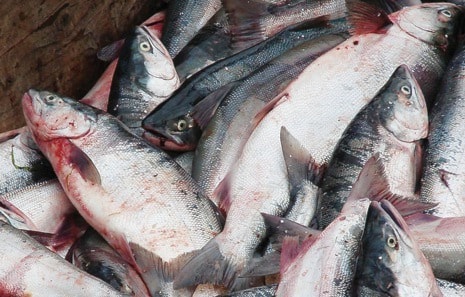Maple Ridge's task force was supposed to find answers, but still only had questions Monday about the effects of last year's gutting of the Fisheries Act.
So far, the federal government hasn't responded to the task force's multi-point resolution from last fall – asking for an explanation of the changes, seeking scientific justification and public consultation, and for restoration of fish habitat protection.
Maple Ridge sent out the report and resolution Oct. 10 to politicians and Fisheries and Oceans Canada, but hasn't heard back.
Two follow-up e-mail inquiries to federal fisheries secretary Randy Kamp have also gone unanswered, planner Rod Stott told council.
One e-mail was sent Oct. 26 to Kamp's office, requesting a follow up on council's questions.
"There's been no response to that e-mail, to date," Stott said.
Another e-mail was sent to Kamp on Jan. 16, again seeking a follow-up and update.
"To date, there's been no response at this time," Stott said.
Kamp was in meetings Tuesday, but ministerial assistant Blair Kestevan said the department has received the report.
"It is in process right now."
Council formed the task force last fall to respond to the changes to Fisheries Act made last year as part of the huge bill C-38. The task force fired off its response to municipal, provincial and federal politicians.
The amended Fisheries Act no longer protects fish habitat and instead says no one can cause "serious harm" to recreational, commercial or aboriginal fisheries.
The federal government, though, is still trying to find wording to implement the act and was looking for public input on how to do that.
Mayor Ernie Daykin wanted to know when that process would finish.
"There's been very little discussion to date, or dialogue, with the municipalities or professional biological associations occurring on who's actually carrying out these changes," Stott replied.
Stott also said the district's streamside protection regulations that determine the development setbacks for streams are working under the new realities of a pared-down Fisheries and Oceans Canada and B.C. Ministry of Environment.
Maple Ridge adopted its own set of stream standards in 2005, developed in consultation with Fisheries and environmental groups. The B.C. government, at the time, allowed cities to keep their own standards or adopt new riparian area regulations where developer-funded environmentalists could determine setbacks for housing projects.
But cities following the latter are worried, Stott said.
Because of staff shortages in senior governments, development projects are taking longer to get government signoff.
Under Maple Ridge regulations, the district has more responsibility in judging setbacks and doesn't need senior government review, because its regulations exceed federal standards.
"That saves applicants a lot of time and money at the end of the day."
Two councillors wanted to review of Maple Ridge's stream protection regulations.
Coun. Michael Morden questioned the accuracy of the district's GPS stream-mapping system. Stott said properties and stream locations are ground truthed by an environmental consultant when a property is being developed.
"The truth of the matter is these maps aren't necessarily accurate," Morden said.
Public works general manager Frank Quinn added that the district's mapping program won an award in 2006.
Morden, though, said some streams on people's property are being labelled as "setback eligible," adding he would support a review, "because there are things that need to be looked at."
Coun. Al Hogarth wanted to ascertain the legal background of Maple Ridge's stream regulations and said, perhaps, the fisheries task force could look at the regulations.
He said he couldn't find any documentation from the provincial government saying the district adopted its regulations with the province's blessing, and "that we did it properly as a council."
Property owners and developers have expressed concern about setbacks on their properties, he added.
"We all want to protect the fish. We all want to protect water quality. But is it always necessary to take a big chunk [of property for a stream setback] as opposed to saying, 'how can we work or mediate with something a little bit smaller that's become less of a burden on us ... and everyone else.'"
However, he added, Maple Ridge's regulations are proving to be "a great thing," in light of changes to the Fisheries Act.
Stott told Coun. Cheryl Ashlie that over the last seven years, he only knows of two cases where streams were later identified on someone's property when development was occurring.
Stott said later that city regulations that protect streams would survive the new Fisheries Act. It's up to each council and community to decide how it wants to protect its streams.
While Maple Ridge will keep its regulations, the question is how expensive it will be for the district to do that.
Maple Ridge sent the task force's final report to several agencies, such as Metro Vancouver, local MPs and MLAs and both fisheries ministers.
Response was limited.
So far, only the town of Oliver and the District of Hudson's Hope supported Maple Ridge's multi-point resolution.
Alouette River Management Society spokesman Geoff Clayton said Kamp was "remiss" in not replying to the district.
Clayton maintained that the legal underpinnings of municipal stream protection will be undermined by the removal of habitat projection from the Fisheries Act.
He questioned Kamp's effectiveness in the process because he hasn't able to get the answers for the community.
Ross Davies with Kanaka Environmental and Education Partnership Society said he was worried about "push-back" against municipal stream regulations because of the changes to the Fisheries Act.
"As far as KEEPS goes, we're quite willing to push back the other way."
